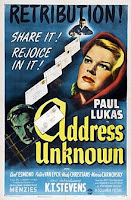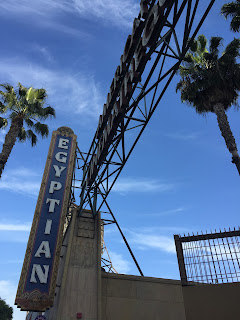Tonight's Movie: The Accused (1949) at the Noir City Film Festival
The Noir City Film Festival has made this a great -- if busy! -- week filled with new discoveries and old favorites.
Wednesday night's double bill paired THE ACCUSED (1949), starring Loretta Young, Robert Cummings, and Wendell Corey, with an old favorite, THE HUNTED (1948), starring Preston Foster and Belita.
I reviewed THE HUNTED after seeing it for the first time at Noir City in 2011, and I also reviewed the 2014 DVD. Please visit those posts to learn more about a terrific "B" film which I've now enjoyed on multiple occasions.
THE ACCUSED was screened in a beautiful 35mm print from the Library of Congress. It's an engrossing film about a psychology professor, Wilma Tuttle (Young), who is physically attacked by one of her students (Douglas Dick) in an isolated Malibu beach area. She fights him off by hitting him with a pipe, but accidentally kills him.
 Panic-stricken Wilma pushes the body off a cliff into the ocean so it will hopefully look like a diving accident...then is so stressed out she promptly collapses with pneumonia and is hospitalized for several days. (This was one of a couple aspects which stretched credulity, but the movie's so interesting I just went along with it.) When she's released she gradually develops a romantic relationship with her late student's uncle (Cummings), a defense attorney. Meanwhile a police detective (Corey) keeps finding bits of evidence that don't quite add up...and, curiously, keep leading back to the professor.
Panic-stricken Wilma pushes the body off a cliff into the ocean so it will hopefully look like a diving accident...then is so stressed out she promptly collapses with pneumonia and is hospitalized for several days. (This was one of a couple aspects which stretched credulity, but the movie's so interesting I just went along with it.) When she's released she gradually develops a romantic relationship with her late student's uncle (Cummings), a defense attorney. Meanwhile a police detective (Corey) keeps finding bits of evidence that don't quite add up...and, curiously, keep leading back to the professor. Young is stuck playing the cliche of the repressed career woman who finally lets loose a little when she falls in love. (She also "lets her hair down" trying to put distance between the description of her in a paper written by the dead man, hoping the police won't connect it with her.) I might also criticize the abrupt ending, which seemed to wrap things up a little too neatly after the viewer has become so invested.
Young is stuck playing the cliche of the repressed career woman who finally lets loose a little when she falls in love. (She also "lets her hair down" trying to put distance between the description of her in a paper written by the dead man, hoping the police won't connect it with her.) I might also criticize the abrupt ending, which seemed to wrap things up a little too neatly after the viewer has become so invested.However, accepting the story as it is, it's quite well scripted and acted. Young is always very good, and while it would have been so much easier if her character just went to the police, she successfully puts across Wilma's fears -- of lack of understanding, notoriety, the loss of her career. One can also accept that, although a smart woman, she was so distraught she might not have counted on a truck driver or a carhop remembering seeing her the night of the death.
 I found the two male leads especially well written. I liked the way it gradually dawns on Cummings that the woman he's come to love must have killed his nephew -- and the way he reacts when almost simultaneously he realizes that the detective is closing in.
I found the two male leads especially well written. I liked the way it gradually dawns on Cummings that the woman he's come to love must have killed his nephew -- and the way he reacts when almost simultaneously he realizes that the detective is closing in.Corey is excellent as the compassionate but dedicated cop who's attracted to Wilma himself but also has a job to do. (For a woman who's lived without love in her life, there's some irony in tragedy bringing not one but two very eligible and interested bachelors into her life.) The scene where he confronts her, as the attorney tries to fend him off, is gripping.
My quibbles with some of the plot choices didn't detract from my overall enjoyment, and all in all I thought this was an excellent 101 minutes spent with three terrific actors.
THE ACCUSED was directed by William Dieterle and filmed in black and white by Milton Krasner.
The supporting cast includes Sara Allgood, Sam Jaffe, Suzanne Dalbert, Mickey Knox, and Ann Doran. Look for Bess Flowers as a prison matron in the final courtroom scene. Henry Travers (IT'S A WONDERFUL LIFE) has a small role as Jaffe's assistant; he made only one more film before retiring.
THE ACCUSED is available on DVD in the Universal Vault series. There's a review of the disc at DVD Beaver.
Coming soon: Reviews of CHICAGO DEADLINE (1949) and I WAS A SHOPLIFTER (1949)...along with a look at TCM in April and a preview of the TCM Classic Film Festival!



























































